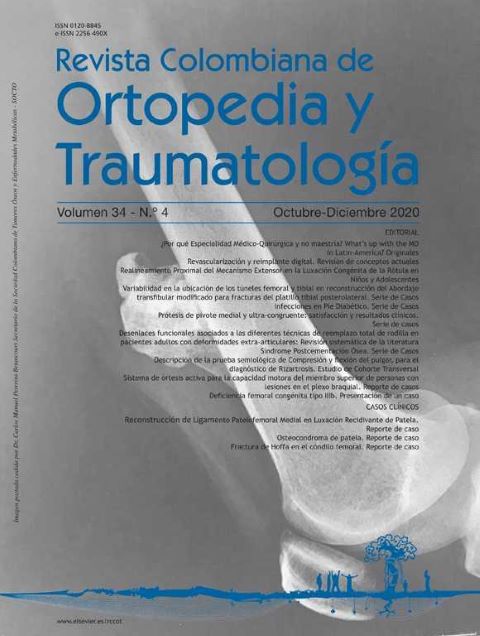Active orthosis system for the motor capacity of the higher member of persons with injuries in the brachial plexus. Case report
DOI:
https://doi.org/10.1016/j.rccot.2020.09.009Keywords:
active orthosis, brachial plexus, motor capacity, electromechanical armAbstract
Background: Active orthosis is one of the main research topics in rehabilitation field and recovery of an injured limb. Within the injuries we can highlight the injury of brachial plexus generates the total loss of motor capacity of the upper limb.
Materials and methods: This research identifies the level of disability of this lesion and seeks to improve the motor capacity of people with lesions in the plexus by using an active orthosis.
Results: We built a printed by a 3D printer with ABS material, and using a MyoWare EMG muscle sensor activated with shoulder muscles to control two servomotors located at elbow and wrist joints.
Discussion: This work was able to improve the motor skills of two patients suffering from this injury, achieving elbow flexion, wrist extension and wrist flexion with the help of the built-in orthosis, as well as identifying some difficulties that must be considered in order to have a fully functional product.
Evidence Level: IV.
Downloads
References
OMS. (2017). OMS - Organización Mundial de Salud. Obtenido de 10 datos sobre la discapacidad: http://www.who.int/features/factfiles/disability/es/.
Alnot JY, Daunois O, Oberlin C, Bleton R. Total paralysis of the brachial plexus caused by supra-clavicular lesions. Rev Chir Orthop Reparatrice Appar Mot. 1992;78:495-504.
Giovacchini F, Vanetti F, Fantozzi M, Cempini M, Cortese M, Parri A, et al. A light-weight active orthosis for hip movement assistance. Robotics and Autonomous Systems. 2015;73:123-34, https://doi.org/10.1016/j.robot.2014.08.015
Gil GA, Moreno JD, Gomez JF, Becerra J, Orozco CH. Rehabilitación temprana de fracturas de mano con órtesis robóticas. Reporte de caso. Rev Col Or Tra. 2018;32:184-90, https://doi.org/10.1016/j.rccot.2017.11.004
Hussain S, Xie SQ, Jamwal PK. Control of a robotic orthosis for gait rehabilitation. Robotics and Autonomous Systems. 2013;61:911-9, https://doi.org/10.1016/j.robot.2013.01.007
Oh S, Mohammed S, Kong K. Design and control of an active ankle-knee orthosis inspired by biarticular musculoskeletal structure of the human lower limb. Robotics and Autonomous Systems. 2016;75(A):107-17, https://doi.org/10.1016/j.robot.2014.09.018
Dos-Santos WM, Caurin GA, Siqueira AAG. Design and control of an active knee orthosis driven by a rotary series elastic actuator. Control Engineering Practice. 2017;58:307-18, https://doi.org/10.1016/j.conengprac.2015.09.008
Shamroukh M, Kalimullah IQ, Chacko A. Evaluation of control strategies in semi-active orthosis for suppression of upper limb pathological tremors. Innovations in Electrical, Electronics, Instrumentation and Media Technology (ICEEIMT), International Conference on, IEEE. 2017:75-80. https://doi.org/10.1109/ICIEEIMT.2017.8116809





